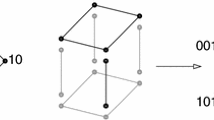Abstract
The general structure and properties of recursion operators for Hamiltonian systems with a finite number and with a continuum of degrees of freedom are considered. Weak and strong recursion operators are introduced. The conditions which determine weak and strong recursion operators are found.
In the theory of nonlinear waves a method for the calculation of the recursion operator, which is based on the use of expansion into a power series over the fields and the momentum representation, is proposed. Within the framework of this method a recursion operator is easily calculated via the Hamiltonian of a given equation. It is shown that only the one-dimensional nonlinear evolution equations can posses a regular recursion operator. In particular, the Kadomtsev-Petviashvili equation has no regular recursion operator.
Similar content being viewed by others
References
Zakharov, V.E., Manakov, S.V., Novikov, S.P., Pitaevski, L.P.: Theory of solitons. Method of the inverse problem. Moscow: Nauka 1980
Solitons. Topics in Current Physics, Vol. 17, Bullough R, Caudrey, P. (eds.). Berlin, Heidelberg, New York: Springer 1980
Ablowitz, M.J., Segur, H.: Solitons and inverse scattering transform. Philadelphia: SIAM 1981
Gardner, C.S., Green, J.H., Kruskal, H.D., Miura, R.M.: Commun. Pure Appl. Math.27, 97 (1974)
Olver, P.J.: Evolution equations possessing infinitely many symmetries. J. Math. Phys.18, 1212–1215 (1977)
Gardner, C.S., Korteweg-de Vries equation and generalizations. IV. The Korteweg-de Vries equation as a Hamiltonian system. J. Math. Phys.12, 1548 (1971)
Zakharov, V.E., Faddeev, L.D.: Funct. Anal. Appl.5, N 4, 18 (1971)
Magri, F.: A simple model of the integrable Hamiltonian equation. J. Math. Phys.19, 1156 (1978)
Kulish, P.P., Reiman, A.G.: Notes of LOMI Sci. Sem.77, 134–147 (1978)
Ablowitz, M.J., Kaup, D.J., Newell, A.C., Segur, H.: Stud. Appl. Math.53, 249–315 (1974)
Flaschka, H., Newell, A.C.: In: Lecture Notes in Physics, Vol. 38, pp. 355–440. Berlin, Heidelberg, New York: Springer 1975
Newell, A.C.: The general structure of integrable evolution equations. Proc. R. Soc. London A365, 283–311 (1979)
Gerdjikov, V.S., Ivanov, M.I., Kulish, P.P.: Quadratic bundle and nonlinear equations. Teor. Mat. Fyz.44, 342 (1980)
Konopelchenko, B.G.: The linear spectral problem of arbitrary order: The general form of the integrable equations and their Bäcklund transformations. Phys. Lett.75, 447–450 (1980), On the structure of integrable evolution equations,79A, 39–43 (1980); On the structure of the commutativeZ 2 graded algebra valued integrable equations,95B, 83–89 (1980); Transformation properties of the integrable evolution equations,100B, 254–260 (1981); On the general structure of integrable equations andZ N -type reductions,108B, 26–32 (1982)
Kulish, P.P.: Notes of LOMI Sci. Sem.96, 105–112 (1980)
Konopelchenko, B.G.: On the structure of equations integrable by the arbitrary-order linear spectral problem. J. Phys. A: Math. Gen.14, 1237–1259 (1981);14, 3125–3143 (1981)
Alonso, L.M.: Schrödinger spectral problems with energy-dependent potentials as sources of nonlinear Hamiltonian evolution equations. J. Math. Phys.21, 2342–2349 (1980); Gel'fand-Dikii method and nonlinear equations associated to Schrödinger operators with energy-dependent potentials. Lett. Math. Phys.4, 215 (1980)
Gerdjikov, V.S., Kulish, P.P.: The generating operator for then ×n linear system. Physica3D, 549–564 (1981)
Konopelchenko, B.G.: Funct. Anal. Appl.16, N 3, 63–65 (1982); Hamiltonian structure of the integrable equations under matrixZ N -reduction. Lett. Math. Phys.6, 309–314 (1982); Physica D (to be published)
Konopelchenko, B.G.: Nonlinear transformations and integrable evolution equations. Fortschritte der Physik,31, 253 (1983)
Dubrovsky, V.G., Konopelchenko, B.G.: Fortschrite der Physik32, N 4 (1984); Preprint Institute of Nuclear Physics, 82–109 (1982); Konopelchenko, B.G., Dubrovsky, V.G.: Ann. Phys. (1984) (to appear), preprint Institute of Nuclear Physics 83–126 (1983)
Gadjiev, I.T., Gerdjikov, V.S., Ivanov, M.I.: Notes of LOMI Sci. Sem.120, 55–68 (1982)
Konopelchenko, B.G.: On the general structure of nonlinear evolution equations integrable by the two-dimensional matrix spectral problem. Commun. Math. Phys.87, 105–125 (1982); General structure of non-linear evolution equations in 1+2 dimensions integrable by the two-dimensional Gel'fand-Dickey-Zakharov-Shabat spectral problem and their transformation properties.88, 531–549 (1983)
Adler, M.: Inventions Math.50, 219–248 (1979)
Reiman, A.G., Semenov-Tyan-Shansky, M.A.: Funct. Anal. Appl.14, N 2, 77–78 (1980)
Gelfand, I.M., Dorphman, I.Ya.: Funct. Anal. Appl.13, N 4, 130–30 (1979);14, N 3, 71–74, (1980)
Funchssteiner, B.: Nonlinear Anal., Theor. Meth. Appl.3, 842–862 (1979); Fuchssteiner, B.: The Lie algebra structure of nonlinear evolution equations admitting infinite dimensional abelian symmetry groups. Prog. Theor. Phys.65, 861–876 (1981);68, 1082–1104 (1982)
Fuchssteiner, B., Fokas, A.S.: Symplectic structures, their Bäcklund transformations and hereditary symmetries. Physica4D, 47–66 (1981)
Fokas, A.S., Anderson, R.L.: On the use of isospectral eigenvalue problems for obtaining hereditary symmetries for Hamiltonian systems. J. Math. Phys.23, 1066–1073 (1982)
Magri, F.: In: Lecture Notes in Physics, Vol. 120, pp. 233–263. Berlin, Heidelberg, New York: Springer 1980
Arnold, V.I.: Mathematical methods of classical mechanics. Moscow: Nauka 1974
Zakharov, V.E.: Ivz. VUZov. Radiofiz.17, 431–453 (1974)
Zakharov, V.E., Kuznetsov, E.A.: Preprint of Institute of automatics and electrometrii, N 186, Novosibirsk (1982)
Zakharov, V.E., Schulman, E.I.: Degenerative dispersion laws, motion invariants and kinetic equations. Physica1D, 192–202 (1980)
Zakharov, V.E.: In: Lecture Notes in Physics, Vol. 153, pp. 190–216. Berlin, Heidelberg, New York: Springer 1982
Author information
Authors and Affiliations
Rights and permissions
About this article
Cite this article
Zakharov, V.E., Konopelchenko, B.G. On the theory of recursion operator. Commun.Math. Phys. 94, 483–509 (1984). https://doi.org/10.1007/BF01403883
Received:
Issue Date:
DOI: https://doi.org/10.1007/BF01403883



